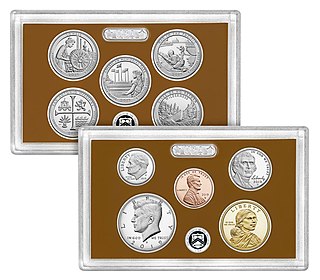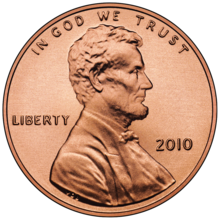Coins of the United States dollar, aside from those of the earlier Continental currency were first minted in 1792. New coins have been produced annually and they make up a valuable aspect of the United States currency system. Circulating coins exist in denominations of 1¢, 5¢, 10¢, 25¢, 50¢, and $1.00. Also minted are bullion, including gold, silver and platinum, and commemorative coins. All of these are produced by the United States Mint. The coins are then sold to Federal Reserve Banks which in turn are responsible for putting coins into circulation and withdrawing them as demanded by the country's economy.

The United States Mint is a bureau of the Department of the Treasury responsible for producing coinage for the United States to conduct its trade and commerce, as well as controlling the movement of bullion. The U.S. Mint is one of two U.S. agencies that produce money in the case of minting coinage; the other is the Bureau of Engraving and Printing, which prints paper currency. The first United States Mint was created in Philadelphia in 1792, and soon joined by other centers, whose coins were identified by their own mint marks. There are currently four active coin-producing mints: Philadelphia, Denver, San Francisco, and West Point.

The dime, in United States usage, is a ten-cent coin, one tenth of a United States dollar, labeled formally as "one dime". The denomination was first authorized by the Coinage Act of 1792.

The dollar coin is a United States coin with a face value of one United States dollar. Dollar coins have been minted in the United States in gold, silver, and base metal versions. Dollar coins were first minted in the United States in 1794.

Proof coinage refers to special early samples of a coin issue, historically made for checking the dies and for archival purposes. Nowadays proofs are often struck in greater numbers specially for coin collectors (numismatists). Nearly all countries have issued proof coinage.

The United States three cent piece was a unit of currency equaling 3⁄100 of a United States dollar. The mint produced two different three-cent coins for circulation: the three-cent silver and the three-cent nickel. Additionally, a three-cent bronze coin was made as a pattern in 1863. During the period from 1865 to 1873, both coins were minted, albeit in very small quantities for the silver three-cent piece.

The United States Bicentennial coinage is a set of circulating commemorative coins, consisting of a quarter, half dollar and dollar struck by the United States Mint in 1975 and 1976. Regardless of when struck, each coin bears the double date 1776–1976 on the normal obverses for the Washington quarter, Kennedy half dollar and Eisenhower dollar. No coins dated 1975 of any of the three denominations were minted.

The Eisenhower dollar was a one-dollar coin issued by the United States Mint from 1971 to 1978; it was the first coin of that denomination issued by the Mint since the Peace dollar series ended in 1935. The coin depicts President Dwight D. Eisenhower on the obverse, and a stylized image honoring the 1969 Apollo 11 Moon mission on the reverse. Both sides were designed by Frank Gasparro, with the reverse based on the mission patch designed by astronaut Michael Collins. It is the only large-size U.S. dollar coin whose circulation strikes contained no silver.

The quarter, short for quarter dollar, is a Canadian coin worth 25 cents or one-fourth of a Canadian dollar. It is a small, circular coin of silver colour. According to the Royal Canadian Mint, the official name for the coin is the 25-cent piece, but in practice it is usually called a "quarter", much like its American counterpart. In Canadian French, it is called a caribou or trente sous. The coin is produced at the Royal Canadian Mint's facility in Winnipeg, Manitoba.

The Kennedy half dollar, first minted in 1964, is a fifty-cent coin issued by the United States Mint. Intended as a memorial to the assassinated 35th president of the United States John F. Kennedy, it was authorized by Congress just over a month after his death. Use of existing works by Mint sculptors Gilroy Roberts and Frank Gasparro allowed dies to be prepared quickly, and striking of the new coins began in January 1964.

The San Francisco Mint is a branch of the United States Mint. Opened in 1854 to serve the gold mines of the California Gold Rush, in twenty years its operations exceeded the capacity of the first building. It moved into a new one in 1874, now known as the Old San Francisco Mint. In 1937 Mint operations moved into a third building, the current one, completed that year.

The West Point Mint is a U.S. Mint production and depository facility erected in 1937 near the U.S. Military Academy in West Point, New York, United States. As of 2019 the mint holds 22% of the United States' gold reserves, or approximately 54,000,000 troy ounces (1,700,000 kg). The mint at West Point is second only to the gold reserves held in secure storage at Fort Knox. Originally, the West Point Mint was called the West Point Bullion Depository. At one point it had the highest concentration of silver of any U.S. mint facility, and for 12 years produced circulating Lincoln cents. It has since minted mostly commemorative coins and stored gold.
This glossary of numismatics is a list of definitions of terms and concepts relevant to numismatics and coin collecting, as well as sub-fields and related disciplines, with concise explanations for the beginner or professional.

The quarter eagle was a gold coin issued by the United States with a value of two hundred and fifty cents, or two dollars and fifty cents. It was given its name in the Coinage Act of 1792, as a derivation from the US ten-dollar eagle coin.
The coins of Canada are produced by the Royal Canadian Mint and denominated in Canadian dollars ($) and the subunit of dollars, cents (¢). An effigy of the reigning monarch always appears on the obverse of all coins. There are standard images which appear on the reverse, but there are also commemorative and numismatic issues with different images on the reverse.
One of the most profitable aspects of the Royal Canadian Mint (RCM) is its numismatic product line. The first numismatic coin from the RCM was arguably the 1935 dollar commemorating the Silver Jubilee of His Majesty King George V. Though intended for circulation, it was the first Canadian coin commemorating an event. The decision to issue this coin was made in October 1934 by then-Prime Minister R.B. Bennett. There were economic and patriotic motivations for the release of a silver dollar, including a hope to boost the silver mining industry. In future years, the silver dollar would have a more emotional meaning for many Canadians because it was also the first coin to have the Voyageur motif on its reverse.
One of the most highly profitable aspects of the Royal Canadian Mint's enterprise is in its Numismatic product line. The euphoria surrounding the year 2000 led to the birth of the Millennium 25-cent coin program. The numismatic line included proof quality coins sold individually or as a complete set. This level of excess would come to signify the coming decade. The number of numismatic releases would increase on an annual basis starting in 2003. Numismatic three cents, five cents, and ten cents would be introduced, along with numismatic three dollars and eight dollars. Luxury coins would not be immune to the dramatic increases that ensued. Coins with face values of 250, 300 and 350 dollars would be introduced by 2006.
The America the Beautiful quarters were a series of fifty-six 25-cent pieces (quarters) issued by the United States Mint, which began in 2010 and lasted until 2021. The obverse (front) of all the coins depicts George Washington in a modified version of the portrait used for the original 1932 Washington quarter. There were five new reverse (back) designs each year, each commemorating a national natural or historic site such as national parks, national historic sites, or national forests – one from each state, the federal district, and each territory. The program was authorized by the America's Beautiful National Parks Quarter Dollar Coin Act of 2008 (Pub. L.Tooltip Public Law 110–456 .
The United States Mint has released annual collections of coins most years since 1936.

The United States Mint Proof Set, commonly known as the Proof Set in the United States, is a set of proof coins sold by the United States Mint. The proof set is popular with coin collectors as it is an affordable way to collect examples of United States coinage in proof condition.













